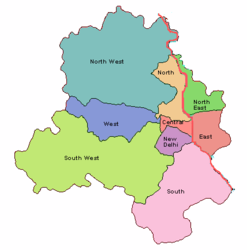Department of Police, Delhi
|
Delhi Police दिल्ली पुलिस |
|
|---|---|
| Common name | DelhiPolice |
| Abbreviation | DP |

Logo of the Delhi Police
|
|
| Motto |
Shanti Seva Nyaya (English: "Peace Service Justice") |
| Agency overview | |
| Formed | 1861. Delhi Police on February 16, 1948 |
| Preceding agency | Municipal Police |
| Employees | 84,536 |
| Annual budget | ₹5,910.28 crore (US$920 million) (2017-18) |
| Legal personality | Governmental: Government agency |
| Jurisdictional structure | |
| Operations jurisdiction* | Union Territory of Delhi, IN |
 |
|
| Map of Delhi Police's jurisdiction. | |
| Size | 1,483 square miles (3,840 km2) |
| Population | 16,753,235 |
| Legal jurisdiction | As per operations jurisdiction. |
| General nature | |
| Operational structure | |
| Headquarters | Indraprasta Estate, New Delhi |
| Police Officers | 70,000 ( Excluding constable staff and head department ) |
| Agency executive | Amulya Patnaik, Commissioner of Police |
| Facilities | |
| Stations | 180 |
| Helicopters | 1 |
| Website | |
| www |
|
| Footnotes | |
| * Divisional agency: Division of the country, over which the agency has usual operational jurisdiction. | |
The Delhi Police is the main law and order agency for the National Capital Territory of Delhi (NCT). It does not have jurisdiction over the adjoining areas of the National Capital Region. The head of the Delhi Police Department is designated as Police Commissioner of New Delhi. In 2015, sanctioned strength of DP was 84,536 (including I.R. Battalions) making it one of the largest metropolitan police forces in the world. About 25 percent of Delhi police strength is earmarked for VVIP security.
The 'Public Order', and Police in Delhi, the National Capital Territory, is under Ministry of Home Affairs (MHA), Government of India and not under the Government of Delhi.
Delhi Police has its origin in a small security force, established in 1854, under the assistant of British Resident to the Mughal Imperial Courts. Founded in 1861 after the adoption of the Indian Police Act, Delhi Police remained a part of the Punjab Police until India gained independence in 1947.
Before 1948 Delhi was part of Punjab Police.
In 1948, Delhi police was restructured. Mr D.W. Mehra became first chief of Delhi Police. Strength of Delhi police in 1951 was about 8,000 with one Inspector General of Police (IGP) and eight Superintendents of Police (SP). In 1956 a post of Deputy Inspector General of Police was created. In 1961, the strength of Delhi police was over 12,000.
In 1966, the Delhi Police on the basis of the Khosla Commission Report was reorganised. Four Police districts, namely, North, Central, South and New Delhi were created. In 1978, the Delhi Police Act was passed and the Commissioner System was introduced with effect from 1 July 1978.
J.N. Chaturvedi (October 1978-Jan 1980), with rank of IGP, became first Commissioner of Delhi Police.
Following the Sixth Central Pay Commission the UPA Government, in 2008, decided to make promotions for Indian Police Service officers, even for higher ranks, time bound. Indian Police Service officers are now promoted on fixed time table, more or less independent of functional requirements or span of responsibility, up to the level of Inspector Generals of Police, at intervals of 4, 9, 13, 14, and 18 years of service. The time bound promotion, much of it non functional, to high ranks apart from increasing the burden on the policing budget has made Delhi Police top heavy, sluggish, and unwieldy. Delhi Police, which had one Inspector General (IG) till Jan 1980s, now has 12 officers with ranks senior to IGPs. They are called Commissioners and Special commissioners, who are in the HAG grades and apex pay grades. In addition Delhi police, instead of one IGP, has several dozen IGPs, as every one gets to be IGP after completion of 18 years service. New IG's functions and responsibilities are no different from that of pre-1980s DIGs and Superintendents of police (SPs).
...
Wikipedia
